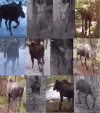Performance of wild animals with "broken" traits: Movement patterns in nature of moose with leg injuries
- PMID: 35923947
- PMCID: PMC9339739
- DOI: 10.1002/ece3.9127
Performance of wild animals with "broken" traits: Movement patterns in nature of moose with leg injuries
Abstract
Organismal traits are presumed to be well suited for performance in the tasks required for survival, growth, and reproduction. Major injuries to such traits should therefore compromise performance and prevent success in the natural world; yet some injured animals can survive for long periods of time and contribute to future generations. We here examine 3 years of camera trap observations along a remote trail through old-growth forest in northern British Columbia, Canada. The most common observations were of moose (2966), wolves (476), and brown bears (224). The moose overwhelmingly moved in one direction along the trail in the late fall and early winter and in the other direction in the spring. This movement was clustered/contagious, with days on which many moose traveled often being interspersed with days on which few moose traveled. On the video recordings, we identified 12 injured moose, representing 1.4% of all moose observations. Seven injuries were to the carpus, three were to the antebrachium, and two were to the tarsus-and they are hypothesized to reflect damage to ligaments, tendons, and perhaps bones. The injured moose were limping in all cases, sometimes severely; and yet they did not differ noticeably from uninjured moose in the direction, date, contagiousness, or speed of movement along the trail. We discuss the potential relevance of these findings for the action of natural selection in the evolution of organismal traits important for performance.
Keywords: functional traits; game camera; lameness; natural selection; trailcam; ungulate.
© 2022 The Authors. Ecology and Evolution published by John Wiley & Sons Ltd.
Conflict of interest statement
The authors are all members of the same family—but did not receive any financial support from research grants, government agencies, NGOs, or businesses.
Figures








Similar articles
-
Temporal variations in female moose responses to roads and logging in the absence of wolves.Ecol Evol. 2024 Feb 1;14(2):e10909. doi: 10.1002/ece3.10909. eCollection 2024 Feb. Ecol Evol. 2024. PMID: 38304262 Free PMC article.
-
Landscape of fear or landscape of food? Moose hunting triggers an antipredator response in brown bears.Ecol Appl. 2023 Jun;33(4):e2840. doi: 10.1002/eap.2840. Epub 2023 Mar 26. Ecol Appl. 2023. PMID: 36912774 Free PMC article.
-
Moose movement rates are altered by wolf presence in two ecosystems.Ecol Evol. 2018 Aug 19;8(17):9017-9033. doi: 10.1002/ece3.4402. eCollection 2018 Sep. Ecol Evol. 2018. PMID: 30271563 Free PMC article.
-
Mobility of moose-comparing the effects of wolf predation risk, reproductive status, and seasonality.Ecol Evol. 2016 Nov 21;6(24):8870-8880. doi: 10.1002/ece3.2598. eCollection 2016 Dec. Ecol Evol. 2016. PMID: 28035275 Free PMC article.
-
Unexplained bacterial meat spoilage during the moose hunting in northern Norway - a review of cases 2008-2021.Acta Vet Scand. 2023 Jul 3;65(1):31. doi: 10.1186/s13028-023-00683-0. Acta Vet Scand. 2023. PMID: 37400877 Free PMC article. Review.
Cited by
-
Does Motility-Restricting Fibrosis Influence Dispersal? An Experiment in Nature With Threespine Stickleback.Ecol Evol. 2024 Dec 12;14(12):e70697. doi: 10.1002/ece3.70697. eCollection 2024 Dec. Ecol Evol. 2024. PMID: 39669507 Free PMC article.
-
The nightjar and the ant: Intercontinental migration reveals a cryptic interaction.Ecol Evol. 2024 May 20;14(5):e11113. doi: 10.1002/ece3.11113. eCollection 2024 May. Ecol Evol. 2024. PMID: 38770123 Free PMC article.
References
-
- Abdelhakiem, M. A. H. , & Elrashidy, M. H. (2017). A retrospective study of the congenital anomalies of the axial and appendicular skeleton in cow calves. Assiut Veterinary Medical Journal, 63, 88–99.
-
- Ahloowalia, B. S. , & Maluszynsk, M. (2001). Induced mutations—A new paradigm in plant breeding. Euphytica, 118, 167–173.
-
- Arnold, S. J. (1983). Morphology, performance and fitness. American Zoologist, 23, 347–361.
-
- Bell, G. , & Gonzalez, A. (2009). Evolutionary rescue can prevent extinction following environmental change. Ecology Letters, 12, 942–948. - PubMed
-
- Bulstrode, C. , King, J. , & Roper, B. (1986). What happens to wild animals with broken bones. The Lancet, 327, 29–31. - PubMed
Associated data
LinkOut - more resources
Full Text Sources

